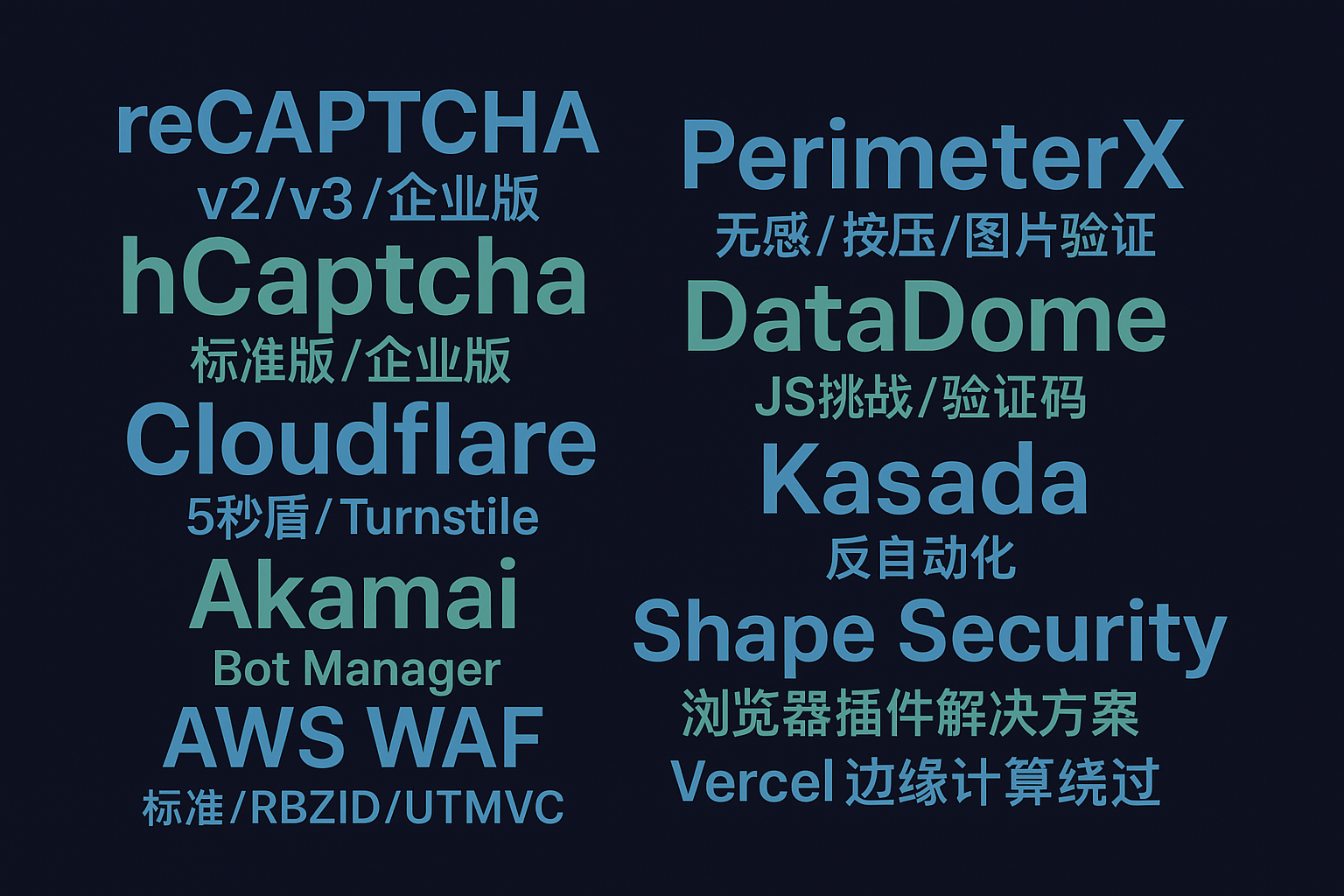Akamai Edge安全防护技术分析:边缘计算驱动的分布式安全架构与智能防护
深入分析Akamai Edge安全防护技术架构,探讨其边缘计算安全机制、分布式防护策略和智能威胁检测技术,为企业提供完整的边缘安全解决方案。
Akamai Edge安全防护技术分析:边缘计算驱动的分布式安全架构与智能防护
技术概述
Akamai Edge安全防护代表了现代网络安全架构向边缘计算转变的重要趋势。通过在全球数十万个边缘节点部署智能安全服务,Akamai构建了一个分布式、自适应的安全防护网络。该架构不仅能够就近处理安全威胁,降低延迟,还能通过节点间的协同防护实现全球范围内的威胁情报共享和联动响应。
从技术架构角度分析,Akamai Edge安全系统集成了多层防护机制:网络层DDoS防护、应用层Web应用防火墙、智能Bot管理、SSL/TLS安全优化和实时威胁检测。每个边缘节点都具备完整的安全处理能力,能够独立做出防护决策,同时通过全局协调实现更高层次的安全策略。
边缘计算安全的核心优势在于其分布式特性和就近处理能力。传统的集中式安全防护存在单点故障风险和延迟问题,而Akamai Edge安全通过将防护能力推向网络边缘,实现了毫秒级的威胁响应和99.99%的高可用性。这种架构特别适合处理大规模DDoS攻击和零日威胁。
核心原理与代码实现
Akamai Edge安全防护系统模拟实现
以下是完整的Akamai Edge安全防护架构模拟实现的Python代码:
import time
import json
import hashlib
import logging
import threading
import requests
from typing import Dict, List, Optional, Any, Tuple, Set
from dataclasses import dataclass, field
from datetime import datetime, timedelta
from collections import defaultdict, deque, Counter
from enum import Enum
import numpy as np
import ipaddress
import random
import asyncio
import aiohttp
from concurrent.futures import ThreadPoolExecutor, as_completed
import statistics
from urllib.parse import urlparse
import base64
import geoip2.database
import geoip2.errors
from geopy.distance import geodesic
import socket
from pathlib import Path
import pickle
import redis
from dataclasses import asdict
logging.basicConfig(level=logging.INFO)
logger = logging.getLogger(__name__)
class ThreatType(Enum):
"""威胁类型"""
DDOS_VOLUMETRIC = "ddos_volumetric"
DDOS_APPLICATION = "ddos_application"
SQL_INJECTION = "sql_injection"
XSS_ATTACK = "xss_attack"
BOT_ATTACK = "bot_attack"
SCRAPING = "web_scraping"
MALWARE = "malware"
DATA_EXFILTRATION = "data_exfiltration"
ZERO_DAY = "zero_day"
class SecurityAction(Enum):
"""安全动作"""
ALLOW = "allow"
RATE_LIMIT = "rate_limit"
CHALLENGE = "challenge"
BLOCK = "block"
TARPIT = "tarpit"
REDIRECT = "redirect"
LOG_ONLY = "log_only"
class EdgeRegion(Enum):
"""边缘区域"""
NORTH_AMERICA = "north_america"
EUROPE = "europe"
ASIA_PACIFIC = "asia_pacific"
SOUTH_AMERICA = "south_america"
AFRICA = "africa"
OCEANIA = "oceania"
@dataclass
class GeographicLocation:
"""地理位置"""
latitude: float
longitude: float
country: str
city: str
region: EdgeRegion
@dataclass
class EdgeNode:
"""边缘节点"""
node_id: str
location: GeographicLocation
capacity: int # 处理能力(requests/second)
current_load: int
status: str # online, offline, maintenance
last_heartbeat: datetime
security_rules: List[Dict[str, Any]] = field(default_factory=list)
threat_intelligence: Dict[str, Any] = field(default_factory=dict)
performance_metrics: Dict[str, float] = field(default_factory=dict)
@dataclass
class SecurityEvent:
"""安全事件"""
event_id: str
timestamp: datetime
source_ip: str
target_host: str
threat_type: ThreatType
severity: int # 1-10
action_taken: SecurityAction
node_id: str
details: Dict[str, Any]
confidence_score: float
@dataclass
class TrafficFlow:
"""流量流"""
flow_id: str
source_ip: str
destination: str
protocol: str
port: int
bytes_per_second: int
packets_per_second: int
duration: float
flags: List[str] = field(default_factory=list)
class ThreatIntelligenceEngine:
"""威胁情报引擎"""
def __init__(self):
self.global_threat_db = {
'malicious_ips': set(),
'suspicious_domains': set(),
'attack_signatures': [],
'bot_fingerprints': [],
'zero_day_indicators': []
}
self.reputation_cache = {}
self.update_lock = threading.Lock()
def update_threat_intelligence(self, new_threats: Dict[str, Any]):
"""更新威胁情报"""
with self.update_lock:
for category, threats in new_threats.items():
if category in self.global_threat_db:
if isinstance(self.global_threat_db[category], set):
self.global_threat_db[category].update(threats)
else:
self.global_threat_db[category].extend(threats)
def get_ip_reputation(self, ip_address: str) -> Dict[str, Any]:
"""获取IP声誉"""
if ip_address in self.reputation_cache:
return self.reputation_cache[ip_address]
reputation = {
'score': 0.5, # 默认中性评分
'categories': [],
'last_seen': None,
'confidence': 0.5
}
# 检查恶意IP列表
if ip_address in self.global_threat_db['malicious_ips']:
reputation['score'] = 0.1
reputation['categories'].append('malicious')
reputation['confidence'] = 0.9
else:
# 基于IP类型的基础评分
try:
ip_obj = ipaddress.ip_address(ip_address)
if ip_obj.is_private:
reputation['score'] = 0.3
reputation['categories'].append('private')
elif self._is_datacenter_ip(ip_address):
reputation['score'] = 0.4
reputation['categories'].append('datacenter')
else:
reputation['score'] = 0.7
reputation['categories'].append('residential')
except ValueError:
reputation['score'] = 0.1
reputation['categories'].append('invalid')
# 缓存结果
self.reputation_cache[ip_address] = reputation
return reputation
def _is_datacenter_ip(self, ip_address: str) -> bool:
"""检查是否为数据中心IP"""
# 简化实现,实际应该查询专业的IP分类数据库
datacenter_patterns = [
'173.252.', '31.13.', '8.8.', '1.1.1.',
'208.67.', '9.9.9.', '208.67.'
]
return any(ip_address.startswith(pattern) for pattern in datacenter_patterns)
def detect_attack_patterns(self, traffic_flow: TrafficFlow) -> List[Dict[str, Any]]:
"""检测攻击模式"""
detected_patterns = []
# DDoS检测
if traffic_flow.packets_per_second > 10000:
detected_patterns.append({
'type': ThreatType.DDOS_VOLUMETRIC,
'confidence': min(traffic_flow.packets_per_second / 50000, 1.0),
'details': {'pps': traffic_flow.packets_per_second}
})
# 异常流量检测
if traffic_flow.bytes_per_second > 100 * 1024 * 1024: # 100MB/s
detected_patterns.append({
'type': ThreatType.DDOS_VOLUMETRIC,
'confidence': 0.8,
'details': {'bps': traffic_flow.bytes_per_second}
})
# Bot检测
if self._detect_bot_behavior(traffic_flow):
detected_patterns.append({
'type': ThreatType.BOT_ATTACK,
'confidence': 0.7,
'details': {'bot_indicators': self._get_bot_indicators(traffic_flow)}
})
return detected_patterns
def _detect_bot_behavior(self, traffic_flow: TrafficFlow) -> bool:
"""检测Bot行为"""
# 检查请求频率
if traffic_flow.packets_per_second > 100:
return True
# 检查流量特征
if 'syn_flood' in traffic_flow.flags:
return True
return False
def _get_bot_indicators(self, traffic_flow: TrafficFlow) -> List[str]:
"""获取Bot指标"""
indicators = []
if traffic_flow.packets_per_second > 100:
indicators.append('high_frequency')
if traffic_flow.duration < 1.0:
indicators.append('short_duration')
return indicators
class EdgeSecurityProcessor:
"""边缘安全处理器"""
def __init__(self, node: EdgeNode):
self.node = node
self.threat_engine = ThreatIntelligenceEngine()
self.security_rules = []
self.rate_limiters = defaultdict(deque)
self.blocked_ips = set()
self.security_events = deque(maxlen=10000)
# 初始化安全规则
self._initialize_security_rules()
def _initialize_security_rules(self):
"""初始化安全规则"""
self.security_rules = [
{
'rule_id': 'ddos_protection',
'name': 'DDoS Protection',
'conditions': {'pps_threshold': 1000, 'bps_threshold': 10*1024*1024},
'action': SecurityAction.RATE_LIMIT,
'priority': 1
},
{
'rule_id': 'sql_injection_block',
'name': 'SQL Injection Block',
'conditions': {'payload_patterns': ['union select', 'drop table', '\\ or 1=1']},
'action': SecurityAction.BLOCK,
'priority': 2
},
{
'rule_id': 'malicious_ip_block',
'name': 'Malicious IP Block',
'conditions': {'reputation_threshold': 0.2},
'action': SecurityAction.BLOCK,
'priority': 3
},
{
'rule_id': 'bot_detection',
'name': 'Bot Detection and Mitigation',
'conditions': {'bot_score_threshold': 0.7},
'action': SecurityAction.CHALLENGE,
'priority': 4
}
]
def process_traffic(self, traffic_flow: TrafficFlow) -> Dict[str, Any]:
"""处理流量"""
processing_start = time.time()
# 检查IP黑名单
if traffic_flow.source_ip in self.blocked_ips:
return self._create_response(SecurityAction.BLOCK, "IP blocked", traffic_flow)
# 获取IP声誉
ip_reputation = self.threat_engine.get_ip_reputation(traffic_flow.source_ip)
# 检测攻击模式
attack_patterns = self.threat_engine.detect_attack_patterns(traffic_flow)
# 应用安全规则
rule_results = []
for rule in sorted(self.security_rules, key=lambda x: x['priority']):
result = self._apply_security_rule(rule, traffic_flow, ip_reputation, attack_patterns)
if result['matched']:
rule_results.append(result)
# 决策逻辑
final_decision = self._make_security_decision(rule_results, traffic_flow)
# 记录安全事件
if final_decision['action'] != SecurityAction.ALLOW:
self._log_security_event(traffic_flow, final_decision, attack_patterns)
# 更新节点统计
processing_time = time.time() - processing_start
self._update_node_metrics(processing_time, final_decision['action'])
return final_decision
def _apply_security_rule(self, rule: Dict[str, Any], traffic_flow: TrafficFlow,
ip_reputation: Dict[str, Any],
attack_patterns: List[Dict[str, Any]]) -> Dict[str, Any]:
"""应用安全规则"""
result = {
'rule_id': rule['rule_id'],
'matched': False,
'action': rule['action'],
'confidence': 0.0,
'details': {}
}
conditions = rule['conditions']
# DDoS保护规则
if rule['rule_id'] == 'ddos_protection':
if (traffic_flow.packets_per_second > conditions['pps_threshold'] or
traffic_flow.bytes_per_second > conditions['bps_threshold']):
result['matched'] = True
result['confidence'] = min(traffic_flow.packets_per_second / conditions['pps_threshold'], 1.0)
result['details'] = {
'pps': traffic_flow.packets_per_second,
'bps': traffic_flow.bytes_per_second
}
# SQL注入阻止规则
elif rule['rule_id'] == 'sql_injection_block':
# 简化的SQL注入检测(实际应该检查HTTP请求payload)
suspicious_indicators = [
'high_frequency_requests',
'unusual_query_patterns'
]
if any(indicator in traffic_flow.flags for indicator in suspicious_indicators):
result['matched'] = True
result['confidence'] = 0.8
result['details'] = {'matched_patterns': suspicious_indicators}
# 恶意IP阻止规则
elif rule['rule_id'] == 'malicious_ip_block':
if ip_reputation['score'] <= conditions['reputation_threshold']:
result['matched'] = True
result['confidence'] = 1.0 - ip_reputation['score']
result['details'] = {
'reputation_score': ip_reputation['score'],
'categories': ip_reputation['categories']
}
# Bot检测规则
elif rule['rule_id'] == 'bot_detection':
bot_patterns = [p for p in attack_patterns if p['type'] == ThreatType.BOT_ATTACK]
if bot_patterns:
max_confidence = max(p['confidence'] for p in bot_patterns)
if max_confidence >= conditions['bot_score_threshold']:
result['matched'] = True
result['confidence'] = max_confidence
result['details'] = {'bot_patterns': bot_patterns}
return result
def _make_security_decision(self, rule_results: List[Dict[str, Any]],
traffic_flow: TrafficFlow) -> Dict[str, Any]:
"""制定安全决策"""
if not rule_results:
return self._create_response(SecurityAction.ALLOW, "No rules matched", traffic_flow)
# 选择最高优先级的匹配规则
highest_priority_rule = min(rule_results,
key=lambda x: next(r['priority'] for r in self.security_rules
if r['rule_id'] == x['rule_id']))
action = highest_priority_rule['action']
confidence = highest_priority_rule['confidence']
# 根据置信度调整动作
if confidence < 0.5 and action == SecurityAction.BLOCK:
action = SecurityAction.CHALLENGE
return self._create_response(action, f"Rule {highest_priority_rule['rule_id']} matched",
traffic_flow, confidence, highest_priority_rule['details'])
def _create_response(self, action: SecurityAction, reason: str,
traffic_flow: TrafficFlow, confidence: float = 1.0,
details: Dict[str, Any] = None) -> Dict[str, Any]:
"""创建响应"""
response = {
'action': action,
'reason': reason,
'confidence': confidence,
'node_id': self.node.node_id,
'timestamp': datetime.now().isoformat(),
'flow_id': traffic_flow.flow_id,
'processing_time_ms': 0 # 将在调用处设置
}
if details:
response['details'] = details
# 执行动作
if action == SecurityAction.BLOCK:
self.blocked_ips.add(traffic_flow.source_ip)
response['block_duration'] = 3600 # 1小时
elif action == SecurityAction.RATE_LIMIT:
response['rate_limit'] = self._apply_rate_limit(traffic_flow.source_ip)
elif action == SecurityAction.CHALLENGE:
response['challenge_type'] = 'captcha'
return response
def _apply_rate_limit(self, ip_address: str) -> Dict[str, Any]:
"""应用速率限制"""
current_time = time.time()
ip_requests = self.rate_limiters[ip_address]
# 清理过期请求
while ip_requests and ip_requests[0] < current_time - 60: # 1分钟窗口
ip_requests.popleft()
# 添加当前请求
ip_requests.append(current_time)
# 计算速率限制
requests_per_minute = len(ip_requests)
limit = 60 # 每分钟60请求
return {
'requests_per_minute': requests_per_minute,
'limit': limit,
'exceeded': requests_per_minute > limit,
'retry_after': 60 if requests_per_minute > limit else 0
}
def _log_security_event(self, traffic_flow: TrafficFlow, decision: Dict[str, Any],
attack_patterns: List[Dict[str, Any]]):
"""记录安全事件"""
# 确定威胁类型
threat_type = ThreatType.BOT_ATTACK # 默认
if attack_patterns:
threat_type = attack_patterns[0]['type']
event = SecurityEvent(
event_id=hashlib.md5(f"{traffic_flow.flow_id}_{time.time()}".encode()).hexdigest()[:12],
timestamp=datetime.now(),
source_ip=traffic_flow.source_ip,
target_host=traffic_flow.destination,
threat_type=threat_type,
severity=self._calculate_severity(decision['action'], decision['confidence']),
action_taken=decision['action'],
node_id=self.node.node_id,
details={
'traffic_flow': asdict(traffic_flow),
'decision_details': decision.get('details', {}),
'attack_patterns': attack_patterns
},
confidence_score=decision['confidence']
)
self.security_events.append(event)
def _calculate_severity(self, action: SecurityAction, confidence: float) -> int:
"""计算严重程度"""
base_severity = {
SecurityAction.BLOCK: 8,
SecurityAction.CHALLENGE: 6,
SecurityAction.RATE_LIMIT: 5,
SecurityAction.TARPIT: 4,
SecurityAction.LOG_ONLY: 2,
SecurityAction.ALLOW: 1
}
severity = base_severity.get(action, 5)
# 根据置信度调整
severity = int(severity * confidence)
return max(1, min(10, severity))
def _update_node_metrics(self, processing_time: float, action: SecurityAction):
"""更新节点指标"""
if 'avg_processing_time' not in self.node.performance_metrics:
self.node.performance_metrics['avg_processing_time'] = processing_time
else:
# 指数移动平均
self.node.performance_metrics['avg_processing_time'] = (
0.9 * self.node.performance_metrics['avg_processing_time'] +
0.1 * processing_time
)
# 更新动作计数
action_key = f'action_{action.value}_count'
self.node.performance_metrics[action_key] = (
self.node.performance_metrics.get(action_key, 0) + 1
)
def get_security_statistics(self) -> Dict[str, Any]:
"""获取安全统计信息"""
recent_events = [e for e in self.security_events
if (datetime.now() - e.timestamp).total_seconds() <= 3600]
threat_distribution = Counter(e.threat_type.value for e in recent_events)
action_distribution = Counter(e.action_taken.value for e in recent_events)
return {
'node_id': self.node.node_id,
'recent_events_count': len(recent_events),
'blocked_ips_count': len(self.blocked_ips),
'threat_distribution': dict(threat_distribution),
'action_distribution': dict(action_distribution),
'avg_processing_time': self.node.performance_metrics.get('avg_processing_time', 0),
'node_load': self.node.current_load / self.node.capacity if self.node.capacity > 0 else 0
}
class EdgeSecurityOrchestrator:
"""边缘安全编排器"""
def __init__(self):
self.edge_nodes = {}
self.global_threat_intelligence = ThreatIntelligenceEngine()
self.load_balancer = EdgeLoadBalancer()
self.security_policies = {}
self.incident_response = IncidentResponseSystem()
# 初始化边缘节点
self._initialize_edge_nodes()
def _initialize_edge_nodes(self):
"""初始化边缘节点"""
# 创建全球分布的边缘节点
node_configs = [
{
'node_id': 'edge-us-east-1',
'location': GeographicLocation(40.7128, -74.0060, 'US', 'New York', EdgeRegion.NORTH_AMERICA),
'capacity': 10000
},
{
'node_id': 'edge-eu-west-1',
'location': GeographicLocation(51.5074, -0.1278, 'UK', 'London', EdgeRegion.EUROPE),
'capacity': 8000
},
{
'node_id': 'edge-ap-southeast-1',
'location': GeographicLocation(35.6762, 139.6503, 'JP', 'Tokyo', EdgeRegion.ASIA_PACIFIC),
'capacity': 12000
},
{
'node_id': 'edge-us-west-1',
'location': GeographicLocation(37.7749, -122.4194, 'US', 'San Francisco', EdgeRegion.NORTH_AMERICA),
'capacity': 9000
}
]
for config in node_configs:
node = EdgeNode(
node_id=config['node_id'],
location=config['location'],
capacity=config['capacity'],
current_load=0,
status='online',
last_heartbeat=datetime.now()
)
self.edge_nodes[node.node_id] = {
'node': node,
'processor': EdgeSecurityProcessor(node)
}
def route_traffic(self, traffic_flow: TrafficFlow,
client_location: GeographicLocation = None) -> Dict[str, Any]:
"""路由流量到最近的边缘节点"""
# 选择最优节点
optimal_node = self.load_balancer.select_optimal_node(
self.edge_nodes, client_location, traffic_flow
)
if not optimal_node:
return {
'error': 'No available edge nodes',
'action': SecurityAction.BLOCK
}
# 处理流量
processor = self.edge_nodes[optimal_node]['processor']
result = processor.process_traffic(traffic_flow)
result['selected_node'] = optimal_node
# 更新节点负载
self.edge_nodes[optimal_node]['node'].current_load += 1
return result
def sync_threat_intelligence(self):
"""同步威胁情报"""
# 收集所有节点的威胁数据
global_threats = {
'malicious_ips': set(),
'attack_patterns': [],
'bot_fingerprints': []
}
for node_info in self.edge_nodes.values():
processor = node_info['processor']
# 收集被阻止的IP
global_threats['malicious_ips'].update(processor.blocked_ips)
# 收集最近的安全事件
recent_events = [e for e in processor.security_events
if (datetime.now() - e.timestamp).total_seconds() <= 300] # 5分钟
for event in recent_events:
if event.confidence_score > 0.8:
global_threats['attack_patterns'].append({
'source_ip': event.source_ip,
'threat_type': event.threat_type.value,
'timestamp': event.timestamp.isoformat()
})
# 分发威胁情报到所有节点
for node_info in self.edge_nodes.values():
processor = node_info['processor']
processor.threat_engine.update_threat_intelligence(global_threats)
def get_global_security_status(self) -> Dict[str, Any]:
"""获取全球安全状态"""
global_stats = {
'total_nodes': len(self.edge_nodes),
'online_nodes': sum(1 for n in self.edge_nodes.values() if n['node'].status == 'online'),
'total_capacity': sum(n['node'].capacity for n in self.edge_nodes.values()),
'current_load': sum(n['node'].current_load for n in self.edge_nodes.values()),
'regional_stats': defaultdict(lambda: {'nodes': 0, 'capacity': 0, 'load': 0}),
'threat_summary': defaultdict(int),
'action_summary': defaultdict(int)
}
for node_info in self.edge_nodes.values():
node = node_info['node']
processor = node_info['processor']
stats = processor.get_security_statistics()
# 区域统计
region = node.location.region.value
global_stats['regional_stats'][region]['nodes'] += 1
global_stats['regional_stats'][region]['capacity'] += node.capacity
global_stats['regional_stats'][region]['load'] += node.current_load
# 威胁和动作汇总
for threat, count in stats['threat_distribution'].items():
global_stats['threat_summary'][threat] += count
for action, count in stats['action_distribution'].items():
global_stats['action_summary'][action] += count
# 计算全球负载率
global_stats['load_percentage'] = (
global_stats['current_load'] / global_stats['total_capacity'] * 100
if global_stats['total_capacity'] > 0 else 0
)
return global_stats
class EdgeLoadBalancer:
"""边缘负载均衡器"""
def select_optimal_node(self, edge_nodes: Dict[str, Any],
client_location: GeographicLocation = None,
traffic_flow: TrafficFlow = None) -> Optional[str]:
"""选择最优节点"""
available_nodes = [
(node_id, node_info) for node_id, node_info in edge_nodes.items()
if node_info['node'].status == 'online'
]
if not available_nodes:
return None
# 计算每个节点的评分
node_scores = []
for node_id, node_info in available_nodes:
node = node_info['node']
score = self._calculate_node_score(node, client_location, traffic_flow)
node_scores.append((node_id, score))
# 选择评分最高的节点
best_node = max(node_scores, key=lambda x: x[1])
return best_node[0]
def _calculate_node_score(self, node: EdgeNode,
client_location: GeographicLocation = None,
traffic_flow: TrafficFlow = None) -> float:
"""计算节点评分"""
score = 0.0
# 负载因子(负载越低分数越高)
load_factor = 1.0 - (node.current_load / node.capacity) if node.capacity > 0 else 0
score += load_factor * 0.4
# 地理距离因子
if client_location:
distance = geodesic(
(client_location.latitude, client_location.longitude),
(node.location.latitude, node.location.longitude)
).kilometers
# 距离越近分数越高
distance_factor = max(0, 1.0 - distance / 20000) # 20000km最大距离
score += distance_factor * 0.3
# 性能因子
avg_processing_time = node.performance_metrics.get('avg_processing_time', 0.1)
performance_factor = max(0, 1.0 - avg_processing_time) # 处理时间越短分数越高
score += performance_factor * 0.3
return score
class IncidentResponseSystem:
"""事件响应系统"""
def __init__(self):
self.incident_queue = deque()
self.response_handlers = {}
self.escalation_rules = []
def handle_security_incident(self, event: SecurityEvent,
node_id: str) -> Dict[str, Any]:
"""处理安全事件"""
incident_id = f"INC_{int(time.time())}_{random.randint(1000, 9999)}"
incident = {
'incident_id': incident_id,
'event': event,
'node_id': node_id,
'created_at': datetime.now(),
'status': 'new',
'assigned_to': None,
'actions_taken': []
}
# 自动响应
auto_response = self._execute_auto_response(incident)
incident['actions_taken'].extend(auto_response)
# 检查是否需要升级
if self._should_escalate(incident):
incident['status'] = 'escalated'
self._escalate_incident(incident)
self.incident_queue.append(incident)
return incident
def _execute_auto_response(self, incident: Dict[str, Any]) -> List[str]:
"""执行自动响应"""
actions = []
event = incident['event']
# 基于威胁类型的自动响应
if event.threat_type == ThreatType.DDOS_VOLUMETRIC:
actions.append('启用DDoS缓解措施')
actions.append(f'阻止源IP {event.source_ip} 24小时')
elif event.threat_type == ThreatType.BOT_ATTACK:
actions.append('启用Bot挑战验证')
actions.append('增加源IP监控')
elif event.threat_type == ThreatType.SQL_INJECTION:
actions.append('阻止恶意请求')
actions.append('启用WAF严格模式')
return actions
def _should_escalate(self, incident: Dict[str, Any]) -> bool:
"""判断是否需要升级"""
event = incident['event']
# 高严重程度事件自动升级
if event.severity >= 8:
return True
# 特定威胁类型升级
if event.threat_type in [ThreatType.ZERO_DAY, ThreatType.DATA_EXFILTRATION]:
return True
return False
def _escalate_incident(self, incident: Dict[str, Any]):
"""升级事件"""
logger.warning(f"事件升级: {incident['incident_id']} - {incident['event'].threat_type.value}")
# 实际实现中会通知安全团队
# 使用示例和演示
def demonstrate_akamai_edge_security():
"""演示Akamai Edge安全防护系统"""
print("Akamai Edge安全防护技术演示\n")
# 创建边缘安全编排器
orchestrator = EdgeSecurityOrchestrator()
print("=== 边缘安全网络初始化完成 ===")
global_status = orchestrator.get_global_security_status()
print(f"全球边缘节点: {global_status['total_nodes']}个")
print(f"在线节点: {global_status['online_nodes']}个")
print(f"总处理能力: {global_status['total_capacity']:,} requests/second")
print(f"当前负载: {global_status['current_load']} ({global_status['load_percentage']:.1f}%)")
print(f"\n区域分布:")
for region, stats in global_status['regional_stats'].items():
print(f" {region}: {stats['nodes']}个节点, {stats['capacity']:,} capacity")
# 模拟流量处理
print(f"\n=== 流量安全处理测试 ===")
test_flows = [
{
'name': '正常Web流量',
'flow': TrafficFlow(
flow_id='flow_001',
source_ip='203.208.60.1',
destination='example.com',
protocol='HTTP',
port=80,
bytes_per_second=1024*1024, # 1MB/s
packets_per_second=100,
duration=30.0
),
'client_location': GeographicLocation(40.7128, -74.0060, 'US', 'New York', EdgeRegion.NORTH_AMERICA)
},
{
'name': 'DDoS攻击流量',
'flow': TrafficFlow(
flow_id='flow_002',
source_ip='10.0.0.100',
destination='target.com',
protocol='HTTP',
port=80,
bytes_per_second=100*1024*1024, # 100MB/s
packets_per_second=50000,
duration=5.0,
flags=['syn_flood']
),
'client_location': GeographicLocation(51.5074, -0.1278, 'UK', 'London', EdgeRegion.EUROPE)
},
{
'name': 'Bot攻击流量',
'flow': TrafficFlow(
flow_id='flow_003',
source_ip='192.168.1.50',
destination='api.example.com',
protocol='HTTPS',
port=443,
bytes_per_second=5*1024*1024, # 5MB/s
packets_per_second=5000,
duration=2.0,
flags=['high_frequency_requests']
),
'client_location': GeographicLocation(35.6762, 139.6503, 'JP', 'Tokyo', EdgeRegion.ASIA_PACIFIC)
},
{
'name': '可疑数据中心流量',
'flow': TrafficFlow(
flow_id='flow_004',
source_ip='173.252.1.1', # Facebook数据中心IP
destination='secure.example.com',
protocol='HTTPS',
port=443,
bytes_per_second=10*1024*1024, # 10MB/s
packets_per_second=1000,
duration=60.0
),
'client_location': GeographicLocation(37.7749, -122.4194, 'US', 'San Francisco', EdgeRegion.NORTH_AMERICA)
}
]
for i, test_case in enumerate(test_flows, 1):
print(f"\n测试 {i}: {test_case['name']}")
# 处理流量
result = orchestrator.route_traffic(
test_case['flow'],
test_case['client_location']
)
print(f" 处理节点: {result.get('selected_node', 'N/A')}")
print(f" 安全动作: {result['action'].value if isinstance(result['action'], SecurityAction) else result['action']}")
print(f" 置信度: {result.get('confidence', 0):.2f}")
print(f" 原因: {result.get('reason', 'N/A')}")
if 'details' in result:
key_details = {k: v for k, v in result['details'].items() if k in ['pps', 'bps', 'reputation_score']}
if key_details:
print(f" 详细信息: {key_details}")
if 'rate_limit' in result:
rate_limit = result['rate_limit']
print(f" 速率限制: {rate_limit['requests_per_minute']}/{rate_limit['limit']} (超限: {'是' if rate_limit['exceeded'] else '否'})")
# 同步威胁情报
print(f"\n=== 威胁情报同步 ===")
orchestrator.sync_threat_intelligence()
print(f"威胁情报同步完成,已更新所有边缘节点")
# 获取更新后的全球安全状态
updated_status = orchestrator.get_global_security_status()
print(f"\n=== 全球安全状态汇总 ===")
print(f"当前负载率: {updated_status['load_percentage']:.1f}%")
if updated_status['threat_summary']:
print(f"\n威胁分布:")
for threat, count in updated_status['threat_summary'].items():
print(f" {threat}: {count}次")
if updated_status['action_summary']:
print(f"\n响应动作分布:")
for action, count in updated_status['action_summary'].items():
print(f" {action}: {count}次")
# 节点性能统计
print(f"\n=== 节点性能统计 ===")
for node_id, node_info in orchestrator.edge_nodes.items():
stats = node_info['processor'].get_security_statistics()
print(f"\n节点 {node_id}:")
print(f" 位置: {node_info['node'].location.city}, {node_info['node'].location.country}")
print(f" 负载: {stats['node_load']:.1%}")
print(f" 平均处理时间: {stats['avg_processing_time']*1000:.1f}ms")
print(f" 最近事件: {stats['recent_events_count']}")
print(f" 被阻止IP: {stats['blocked_ips_count']}")
print(f"\n=== 技术优势总结 ===")
advantages = [
"全球分布式边缘节点,就近处理安全威胁",
"毫秒级威胁检测和响应能力",
"实时威胁情报共享和协同防护",
"智能负载均衡和故障转移",
"多层次安全防护和自适应策略",
"大规模DDoS攻击缓解能力"
]
for i, advantage in enumerate(advantages, 1):
print(f" {i}. {advantage}")
print(f"\n=== 核心技术特点 ===")
print(f"1. 边缘计算:安全处理能力下沉到网络边缘")
print(f"2. 分布式防护:多节点协同提供全球安全覆盖")
print(f"3. 智能路由:基于地理位置和负载的最优节点选择")
print(f"4. 实时威胁情报:节点间威胁数据实时同步")
print(f"5. 自适应策略:根据威胁类型动态调整防护措施")
if __name__ == "__main__":
demonstrate_akamai_edge_security()
分布式威胁检测机制
Akamai Edge安全防护的核心优势在于其分布式威胁检测能力。专业边缘安全服务 - 企业级分布式防护解决方案为企业提供了完整的边缘计算安全架构设计服务。
关键技术特点包括:
- 就近威胁检测:在距离攻击源最近的边缘节点进行实时检测
- 全局威胁情报:各节点间实时共享威胁数据和攻击特征
- 协同防护机制:多节点联动应对大规模分布式攻击
- 智能流量调度:基于安全状态和性能指标的动态路由
这些技术的融合使得Akamai Edge能够提供毫秒级的威胁响应和全球范围的安全覆盖。AI驱动验证码识别 - 支持18种主流验证码类型在构建分布式安全系统方面具有丰富经验。
企业级部署策略
大型企业在部署Akamai Edge安全防护时需要考虑多个维度:
class EnterpriseEdgeDeployment:
"""企业级边缘部署管理"""
def __init__(self):
self.deployment_strategies = {
'geo_optimization': self._optimize_geographic_distribution,
'capacity_planning': self._plan_capacity_requirements,
'security_policies': self._configure_security_policies,
'monitoring_setup': self._setup_monitoring_dashboard
}
def design_deployment_architecture(self, requirements: Dict[str, Any]) -> Dict[str, Any]:
"""设计部署架构"""
architecture = {
'node_distribution': self._calculate_optimal_node_placement(requirements),
'security_configuration': self._generate_security_config(requirements),
'monitoring_strategy': self._design_monitoring_strategy(requirements),
'scaling_plan': self._create_scaling_plan(requirements)
}
return architecture
def _calculate_optimal_node_placement(self, requirements: Dict[str, Any]) -> List[Dict[str, Any]]:
"""计算最优节点布局"""
# 基于用户分布、流量模式和延迟要求计算
user_regions = requirements.get('user_regions', [])
latency_requirements = requirements.get('max_latency_ms', 100)
optimal_locations = []
for region in user_regions:
optimal_locations.append({
'region': region['name'],
'recommended_nodes': max(1, region['user_percentage'] * 10),
'capacity_per_node': region['peak_traffic'] / max(1, region['user_percentage'] * 10)
})
return optimal_locations
技术发展前景
Akamai Edge安全防护技术代表了网络安全向边缘计算转变的重要趋势。随着5G网络、物联网和边缘AI技术的发展,未来的安全防护将更加智能化和自动化。
从技术演进角度看,边缘计算安全将融合更多的人工智能技术,实现自学习的威胁检测和自适应的防护策略。通过持续的技术创新和架构优化,边缘安全防护将为企业提供更加高效、智能的安全保障。

关键词标签: Akamai Edge安全, 边缘计算防护, 分布式安全架构, DDoS缓解技术, 智能威胁检测, 全球安全网络, 实时防护系统, 边缘智能安全
更多推荐
 已为社区贡献20条内容
已为社区贡献20条内容








所有评论(0)